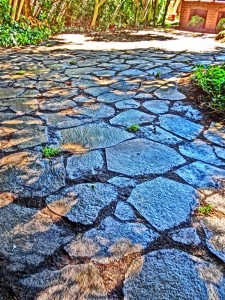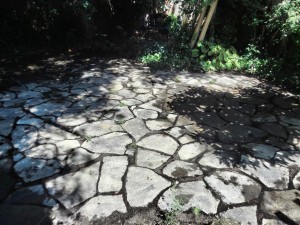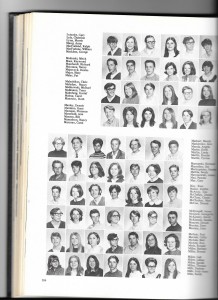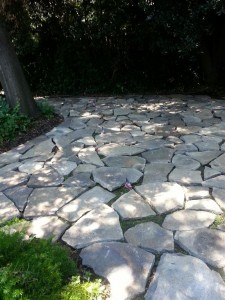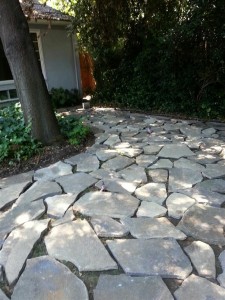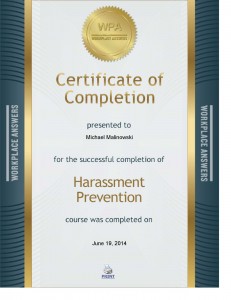I had suggested Jeanne Gang present the Julia Morgan FAIA Gold Medal candidacy to the National Board of Directors. Jeanne’s passion and engaging style were a key part of success – resulting in Julia Morgan FAIA’s finally being appropriately recognized: the first woman elevated to this honor in the 150 + year history of the AIA!
Transformation of my backyard is complete: from grass to ROCK
Permit Streamlining: Architects as Change Agents
We strive to make your experience as a speaker positive and memorable. We would appreciate if you could share your feedback with us about your experience at the AIA Convention 2014. Please take a couple of minutes to complete this survey and share your thoughts with us: https://www.surveymonkey.com/s/H6S6T39 Thank you. AIA Convention Education Team Feedback from the presentation in Chicago at the AIA Convention (MFMalinowski AIA and Robert Wible) CES Common Evaluation Results FR206: Permit Streamlining: Architects as Change Agents CONTENT 100% of survey respondents would recommend your session to my colleagues. 83% of survey respondents thought your presentation included real-life, practical examples and/or anecdotes. Using a scale from 1 to 5 where 1 is “Strongly Disagree” and 5 is “Strongly Agree,” your presentation received the following scores: 4.83 Content was timely and relevant. 4.67 Provided practical takeaways that I can apply to my job. 4.50 Content was in-depth and challenging enough. 4.67 Content will help me be more effective and valuable to my employer and/or clients. DELIVERY 83% of survey respondents thought the course flow was clear, sequential and deliberate. 83% of survey respondents thought the audio-visual, handouts and/or supplemental materials were useful and supported their learning in the course. Using a scale from 1 to 5 where 1 is “Strongly Disagree” and 5 is “Strongly Agree,” your presentation received the following scores: 4.83 The presenter was an authority on this topic. 4.83 The presenter(s) was (were) engaging 4.83 Session was interactive and involved audience participation. OVERALL RATING Survey respondents on average rated your presentation as 9.33 out of 10. COMMENTS . AIA should provide more code related courses . Why isn’t there more code related classes? This class could have lasted 2 more hours . Not specific with practical steps of implementation . Presenters Mike and Bob created a very engaging, visually stimulating presentation on permit streamlining, especially the video on AutoCodes. While I believe that architects should not continue ceding authority or autonomy to third parties in the field that may not possess the same level of expertise, education, accreditation, etc. on certain projects — I believe architects should be seizing the leadership role on codes/standards — this course examined a lot of salient issues to the profession and some of ways they will be addressed in the future through electronic platforms like AutoCodes. . would like more sessions where code analysis is covered!
Mike in the 1969 Denby Yearbook … thanks to Charles Cole FAIA
Rock … rock and more rock …
Eight thousand pounds of rock . each piece individually picked up, studied for texture, color and pattern, and placed (with some trial and error) a composition takes shape . the beginnings of a backyard with no lawn . aching back coincides with temperatures creeping over 100 degrees but the result – so far – speaks for itself – a great team effort! It’s going to be beautiful and very functional . and of course rock needs less water than lawn . Next tasks: getting these babies level . and ready for the finishing touch: interstitial planting . maybe Corsican mint? .
Heard at AIA Convention
If you want to go fast, go alone If you want to go far, travel together Google says this is an African saying . heard from John Padillia in his run for AIA Secretary
Harassment training completed
Hitchhiker
18 Things Creative People Do
As shared with me by Richard Raisler: 18 Things Creative People Do Creativity is far mare than the right/left brain distinction we’ve come to know. Science now understands that creative thinking calls for complex brain processes, distinct neural pathways and emotions; making it very different from the standard thinking process we all use every day. Research has found that creativity involves the coming together of many traits, behaviors and social influences in a single person. The so-called “tortured” creative may in fact be a more complex person than say an accountant or programmer. So, let’s look at some of the characteristics and behaviors that creative people share. 1. They daydream, knowing this isn’t a waste of time. Mind wandering has been shown to help the process of creative incubation. Also, lots of time great ideas come out of the blue, when we’re thinking about something else. 2. They observe, seeing possibilities and potential in all things. They are constantly taking in details that are then the basis for creative expression. 3. They work hours that work for them. Some people are naturally better in the morning; others are more plugged in late at night. Creatives know what time of day they work best, and structure their time to accommodate that. 4. They spend time alone, without fear. They are comfortable spending time alone, allowing the mind to wander. 5. They turn obstacles around, using pain or hurt as the catalyst to creative growth and the chance to see new possibilities. It’s the fuel that brings a new perspective on reality. 6. They seek new experiences. Being open to new experiences, sensations and states or mind is a good predictor of creative ability. Openness to experience is the strongest predictor of achievement in a creative field. 7. They are resilient, with the ability not to take failure as something personal. Really good creative fail a lot. 8. They ask big questions. Creatives are always looking for answers, generally living an examined life. They look around and want to know the why and how of why things are the way they are. 9. They people watch so they become keen observers of human nature. This practice can supply some of their best ideas. 10. They take risks, thriving off the feeling of putting things out there. Being a true creative is not for the timid or thin skinned. Or anyone too caught up in what others may think of them. 11. They see life as a chance to express themselves. 12. They follow their real passions. They are motivated to act based on an internal desire and are energized by challenging activities. 13. They get out of their own heads, putting distance between ones own limited perspective and looking at other ways of thinking and living. 14. They lose track of time, so when they are working they get “in the zone” (also known as a flow state) and this helps them create at a higher level. 15. They surround themselves with beautiful things. Creative people tend to have exceptional taste, and they enjoy having beautiful things around. 16. They connect the dots, seeing possibilities where other people don’t. Creativity is the ability to connect dots that others might not think to connect. 17. They constantly shake things up to get a diversity of experience that is key to being creative. 18. They make time to be mindful. These people know the value of a clear, focused mind, and meditation is a wonderful tool for achieving that end. Richard A. Raisler Founder trueHUEnews
My answers to some good quesions posed by Shannon Calder at AIACC
Good Firms and Healthy Practices . What do the best firms do to be successful? Survival is the core ‘best practice’ – and still a challenge for many as the recovery is spotty both geographically and re work type. After survival one can start to consider mentoring; customer service; community service; and service to the profession. . How do best firms create a model for others? Sharing; which is tough in a hyper competitive environment. Sharing best practices is the only way all boats can rise. . What defines a great practice? Open / sharing culture that transends fear of competition; sustainable business practices that transend business climate fluctuations; consistent investment in building connections to the public, allied professions, the aia, employees / prospective employees, students, and – oh yeah – clients . . What was the defining point which inspired you to jump off and begin your own firm? Ego and confidence conspired to make that leap possible; once leapt, hard to climb back onto the ledge . What do you think is the single biggest issue impacting the profession in the future? Relevance to the business community and the public. If the profession is thriving, there is energy and time for all the rest to fall into place; where there is no prosperity, all that is good is challenged and struggles. Michael F. Malinowski AIA President, Applied Architecture Inc

